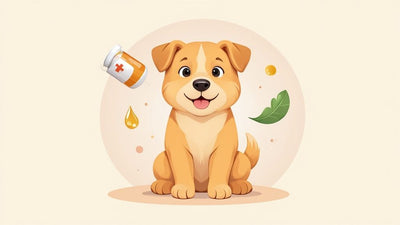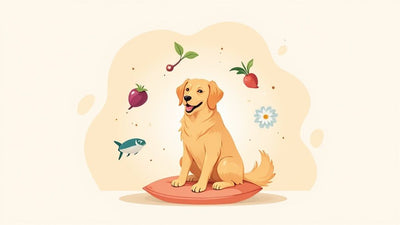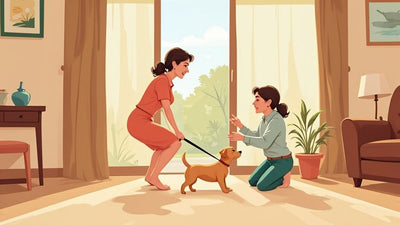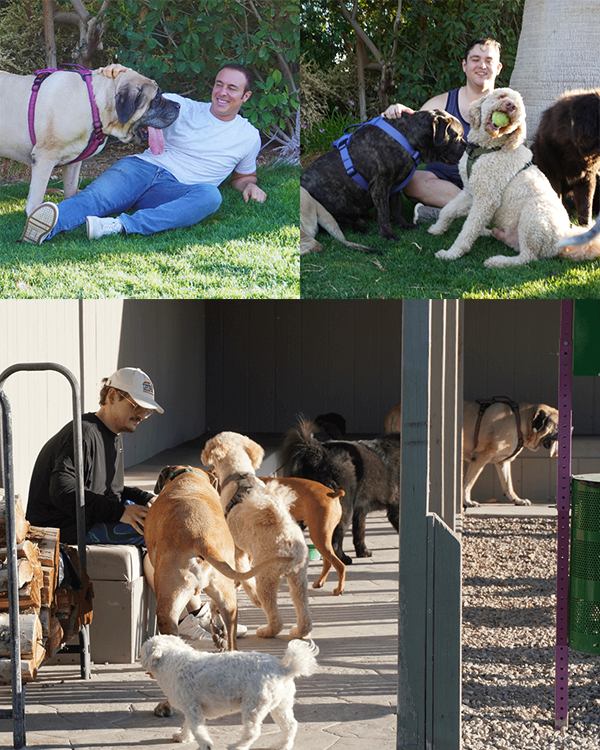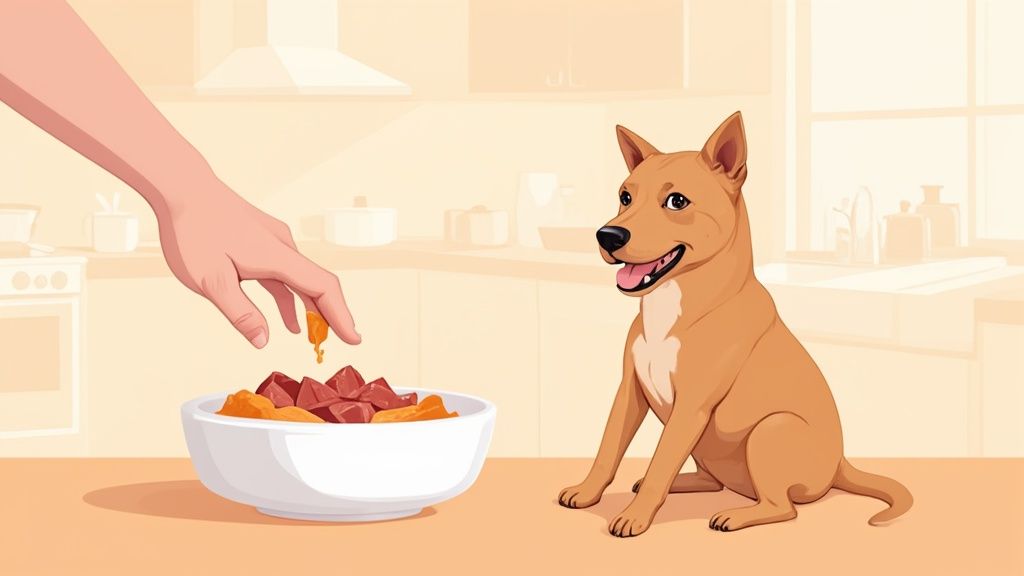
What to Feed a Dog to Gain Weight Safely
When you’re trying to help your dog gain weight, the journey starts with a simple focus: a high-quality, calorie-dense diet filled with nourishing protein and healthy fats. Often, this means choosing a food made for active dogs or puppies, or sometimes just adding gentle, nutrient-packed toppers to their regular meals.
Is Your Dog Underweight or Just Lean?
It’s completely normal to feel a pang of worry when your dog starts looking a bit too thin. We’ve been there. Before we jump into changing their diet, the first real step is to understand if your dog is genuinely underweight or just naturally lean and athletic. Some breeds are just built that way.
This isn't about becoming a vet overnight. It’s about being an observant companion who knows their dog best. A quick, gentle at-home body check can give you a much clearer picture and help you decide if it's time for the next step.
Performing a Gentle At-Home Body Check
You can learn so much just by touch. Gently run your hands over your dog's ribcage. You should be able to feel the ribs beneath a thin layer of fat, but they shouldn't be sticking out sharply or feel like you're running your fingers over a comb.
Next, feel along their spine and over their hips. In a healthy dog, you'll feel the bones, but they won't feel prominent or sharp. If those bones are jutting out with very little cushioning, that’s a gentle sign your dog could use some extra support.
A Gentle Guideline: A dog at a healthy weight will have a visible "waist" when you look down at them, and their belly should tuck up from their chest when you see them from the side. If that tuck is extreme or you can easily see every bone, it’s a sign to pay closer attention.
The infographic below shows exactly where you should be feeling to check your dog's body condition.
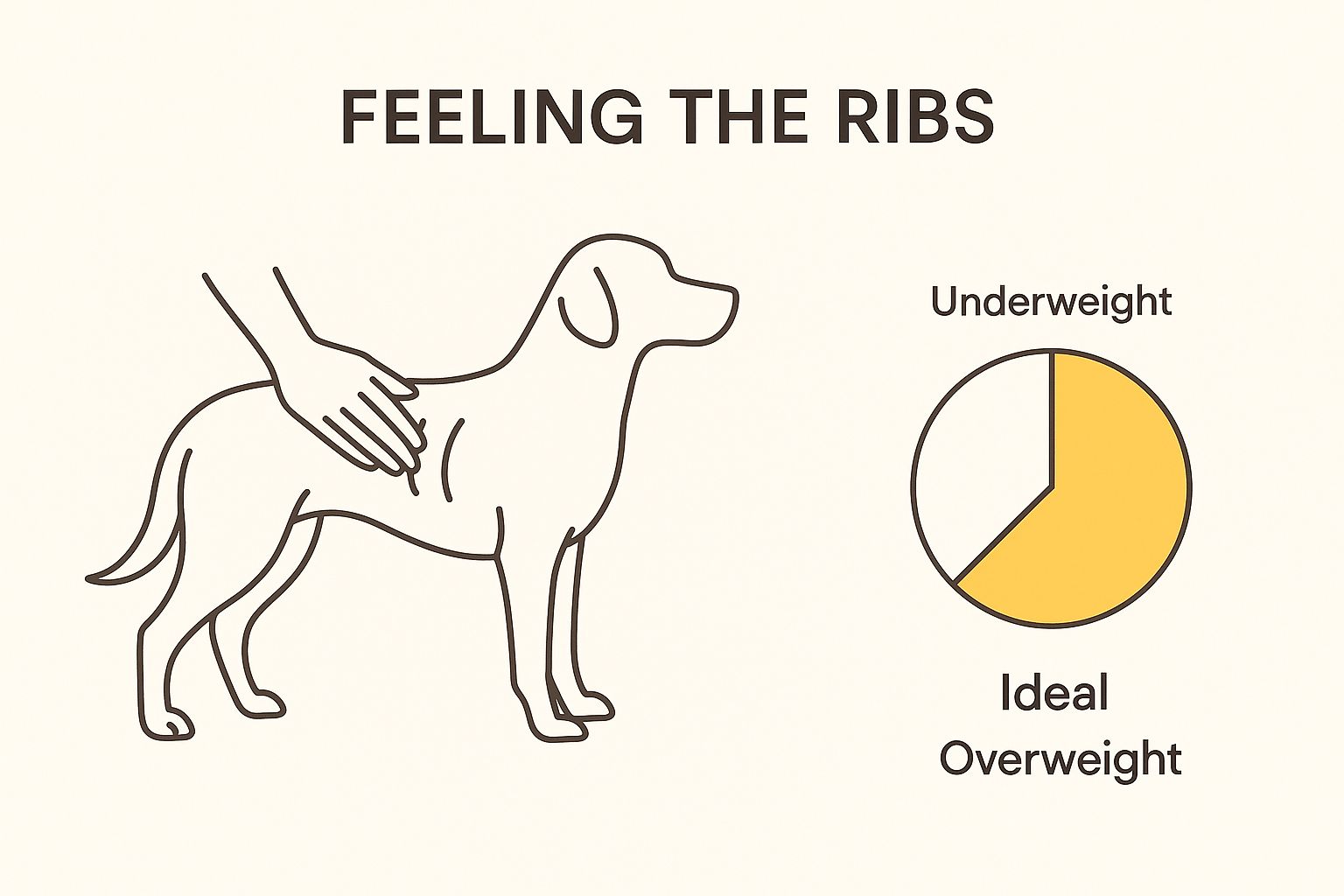
As the illustration shows, it’s all about using a gentle touch to assess that thin fat layer over the ribs—it’s one of the best indicators of a healthy weight.
To make it even easier, here's a quick comparison to help you tell the difference between a dog that's lean and one that's underweight.
Quick Guide to Your Dog's Body Condition
Use this checklist to help you tell the difference between a healthy lean dog and an underweight dog.
| Physical Sign | What You Might See in an Underweight Dog | What Is Typical for a Healthy Weight Dog |
|---|---|---|
| Ribs | Easily visible, sharp to the touch, with no palpable fat. | Easily felt with a slight fat covering, but not visible. |
| Spine | Vertebrae are prominent and feel sharp. | You can feel the spine, but individual vertebrae aren't obvious. |
| Hip Bones | Hip bones are very noticeable and jut out. | Smoothly covered; you can feel them but they aren't sharp. |
| Waist | A severe "hourglass" shape when viewed from above. | A clear waist is visible behind the ribs from above. |
| Abdominal Tuck | An extreme tuck is visible from the side. | A gentle upward slope from the chest to the hind legs. |
This little checklist is a great starting point, giving you something tangible to discuss when you talk to your vet.
Common Reasons for Unexplained Weight Loss
Sometimes, weight loss has a simple explanation—maybe you've just brought home a rescue who is still settling in, and you're helping them on their journey. Other times, the cause is a bit harder to pin down. Knowing the possibilities can make your vet visit much more productive.
A few common culprits include:
- Stress or Anxiety: Big changes like a move or a new baby can put a dog off their food. If you're looking into ways to help a stressed-out pup, you might find it useful to read about natural supplements like ashwagandha for dogs.
- Picky Eating Habits: We understand that some dogs are just plain fussy. Finding a food they genuinely enjoy can sometimes feel like a full-time job.
- Increased Activity: Have you started a new running routine together or spent more time at the dog park? They could simply be burning far more calories than they're taking in.
- Underlying Health Issues: This is the big one. Things like dental pain, digestive troubles, or other medical problems are frequent causes of weight loss and always need a vet's attention.
Get Your FREE Dog Brain Health Guide

Get instant FREE access to today's top ways to help your best friend live a longer, healthier, happier life.
- 39 value-packed pages of expert insights
- Early-detection tips for cognitive decline
- Top brain-boosting superfoods
- Vet-approved mental sharpness strategies
- Fun IQ tests for your dog
The Foundation of Healthy Weight Gain for Dogs
When you notice your dog is looking a bit too lean, the natural impulse is to just start heaping more food into their bowl. We get it. It feels like the most direct solution. But putting on healthy weight is about so much more than just piling on pounds; it’s about rebuilding your dog’s strength and comfort from the inside out.
We’re aiming for healthy, lean muscle, not just fat. To do that, we need to shift our focus from the quantity of food to the quality of the calories. It all comes down to three nutritional cornerstones: protein, fat, and carbohydrates. Each one has a specific, vital job to do.
The Power of High-Quality Protein
Think of protein as the literal building blocks for your dog's body. It’s absolutely essential for repairing tissues and, most importantly, for developing the strong, lean muscle mass they’ve lost. But here’s the thing: not all protein is created equal. The best sources are highly digestible, which simply means your dog's system can easily break them down and put them to work.
When you're scanning a food label, keep an eye out for whole-protein sources at the very top of the ingredient list.
- Look for specifics like chicken, turkey, beef, or fish.
- Egg is another fantastic, complete protein source.
- Try to steer clear of foods that rely on vague terms like "meat meal" or by-products as the main ingredients.
A diet built on high-quality protein gives your dog the foundation they need to get their energy and strength back, one meal at a time.
Healthy Fats Are a Super-Fuel
Fat is the most concentrated source of energy you can give your dog. In fact, it packs more than double the calories per gram compared to proteins or carbs. This makes it an incredibly efficient tool for weight gain. You can seriously boost the calorie count of a meal without adding a ton of extra volume—a huge plus if your dog’s appetite isn’t what it used to be.
Vets often recommend therapeutic diets for underweight dogs that contain elevated protein (up to 40%) and a higher fat content (up to 20%). A study published in Nature confirmed this approach helps promote healthy muscle development, not just fat storage.
Beyond calories, healthy fats are crucial for skin and coat health and support overall cell function. Foods rich in omega-3 and omega-6 fatty acids are fantastic. Adding something like fish oil not only adds calories but also has anti-inflammatory properties, which is a wonderful, gentle way to support their entire system.
For a deeper dive into how these oils can make a difference, check out our guide on the benefits of Alaskan salmon oil for dogs.
Choosing Smart Carbohydrates
Carbohydrates sometimes get a bad rap, but the right kind are an excellent source of quick energy and fiber. They provide the fuel your dog needs to get through the day, which allows the protein they eat to be used for muscle building instead of being burned for energy.
The trick is to choose complex carbohydrates that provide a slow, steady release of energy. Good ones to look for include:
- Sweet potatoes
- Brown rice
- Oats
- Peas
These ingredients deliver sustained fuel and also aid in digestive health, making sure your dog can actually absorb all those great nutrients you're feeding them. Put these three components together, and you have the perfect nutritional blueprint for a safe and effective weight gain plan.
Choosing High-Calorie Foods Your Dog Will Love
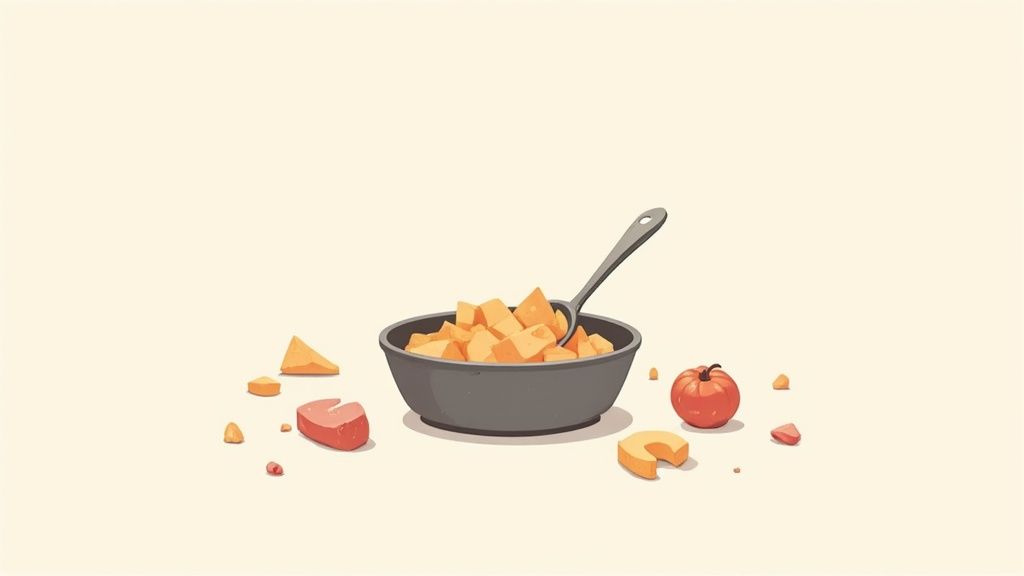
Staring at an entire aisle of dog food can feel overwhelming. We understand. You want to make the best choice to help your dog regain their strength and vitality, and the pressure is on. The good news is, you don’t need to be a canine nutritionist to make a smart decision.
The goal is to find nutrient-dense, high-calorie foods that are still easy for your dog to digest. For many underweight dogs, a great place to start is with commercial foods formulated for performance dogs or even puppies. These diets are already packed with the higher protein and fat content needed to support growth and high energy, which makes them a perfect match for healthy weight gain.
Selecting The Right Commercial Food
When you're comparing different bags of food, just flip them over. The two most important things to check are the ingredient list and the guaranteed analysis panel.
You're looking for a food that lists a high-quality animal protein—like chicken, beef, or fish—as the very first ingredient. Then, glance at the fat content. It should be noticeably higher than a standard adult maintenance diet, ideally somewhere around 18-20%.
We know this journey is about more than just food; it’s about providing complete support for your dog's well-being. For those interested in how diet impacts overall health, you can explore our detailed guides on canine nutrition and supplements to learn more about supporting them from the inside out.
Remember, there's no need to make a drastic switch overnight. The kindest thing for your dog’s digestive system is a slow and steady transition. Mix the new food with their old one over 7-10 days, gradually increasing the new and decreasing the old.
The Gentle Power Of Food Toppers
Sometimes, you don't need a whole new bag of kibble. If you're dealing with a picky eater or a sensitive stomach, simply enriching their current meal with a few healthy additions can make all the difference. These whole-food "toppers" can boost calories and nutrients while also making their bowl a lot more interesting.
It's all about making small, positive changes. A spoonful of a healthy topper is a fantastic way to add nourishment and show a little extra love.
Adding a little something extra to their bowl is an easy way to boost calories without causing an upset stomach. Here are a few simple, safe, and effective options we often recommend.
Safe and Healthy Food Toppers to Boost Calories
| Food Topper | Why It Helps | Suggested Serving for a 40lb Dog |
|---|---|---|
| Cooked Sweet Potato | A fantastic source of complex carbs for sustained energy, plus fiber for digestive health. | 1-2 tablespoons, mashed |
| Plain Canned Pumpkin | Rich in fiber and moisture, it helps with digestion and adds enticing flavor without excess calories. | 1 tablespoon |
| Boiled Chicken (unseasoned) | An excellent, highly digestible protein source to support lean muscle development. | 2 tablespoons, shredded |
| Plain, Full-Fat Yogurt | Provides calcium, protein, and probiotics to support a healthy gut. Ensure it contains no xylitol. | 1 teaspoon |
| Sardines in Water (no salt added) | Packed with omega-3 fatty acids for skin and coat health, plus a great protein and calorie boost. | 1 sardine, mashed |
Just keep in mind that these are meant to be additions, not meal replacements. It's always best to start with small amounts to see how your dog handles them. These simple acts can turn mealtime into a more joyful and nourishing experience, helping your best friend get back to a healthy weight, one loving spoonful at a time.
How to Create a Gentle and Effective Feeding Routine
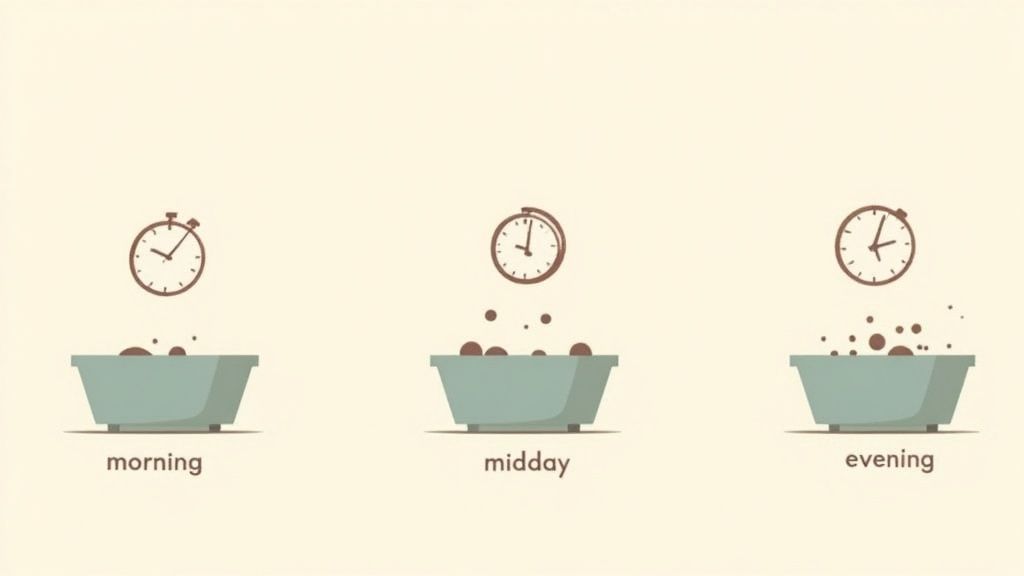
When you're trying to help your dog get back to a healthy weight, it’s about more than just the food in their bowl. It’s a journey of patience and consistency. The key isn't just what you're feeding them, but how you build a routine that supports their body without overwhelming it. A gentle, structured approach is your best friend here, turning mealtime from a challenge into a positive, healing experience.
Most of us are in the habit of feeding our dogs twice a day. But for an underweight dog, two large meals can be a lot for their digestive system to handle. We’ve found a much kinder and more effective strategy is to offer smaller, more frequent meals. This simple switch helps keep their energy levels stable and gives their body a better chance to absorb all those crucial nutrients.
Building a Nurturing Schedule
Think of it as moving away from a feast-or-famine cycle and toward a steady stream of nourishment. This small change can make a massive difference in their comfort and how quickly they start to feel better.
A simple, supportive schedule might look something like this:
- Morning Meal (around 7 AM): A small, easy-to-digest portion to start the day.
- Mid-Day Meal (around 12 PM): Another small meal to refuel and prevent afternoon energy slumps.
- Evening Meal (around 5 PM): Their final meal of the day, given well before bedtime to allow for proper digestion.
This kind of routine does more than just aid digestion. It also builds positive anticipation for meals, which can be a huge motivator for a dog whose appetite isn't what it used to be.
Calculating a Gentle Calorie Increase
When it’s time to increase their food, the mantra is "slow and steady." A sudden jump in calories can easily lead to digestive upset like diarrhea or vomiting—the last thing you want. The goal is a gentle, gradual increase, usually starting with about 10-20% more calories than what they're currently eating.
Let's say your dog is eating 1,000 calories per day right now. You’d aim for a new total of 1,100 to 1,200 calories. Then, you'd divide that new amount across their smaller, more frequent meals. This gives their system time to adapt comfortably.
As owners, our feeding habits are one of the biggest factors in our dogs' health. The most successful weight management plans—whether for gain or loss—are always built on a solid understanding of portion control and food quality. When we're helping a dog gain weight, the focus shifts to enriching their diet with highly digestible fats and proteins. Just as important is making sure their activity level supports lean muscle growth, not just fat storage. In fact, detailed research findings show just how much owner education can impact a dog's health outcomes.
A Gentle Reminder: This is a marathon, not a sprint. Every dog's journey is unique, and their body will respond at its own pace. What matters most is creating a calm, stress-free environment around food.
By pairing a thoughtful routine with a gradual increase in high-quality calories, you’re creating a powerful foundation for healthy, sustainable weight gain. It's a quiet promise to your dog that you’re right there with them, one loving meal at a time.

Support Your Dog's Brain Health with NeuroChew™
As mentioned in this article, NeuroChew is the first dog chew designed to support both cognitive function and healthy circulation. Perfect for dogs showing early signs of cognitive decline or for proactive brain health support.
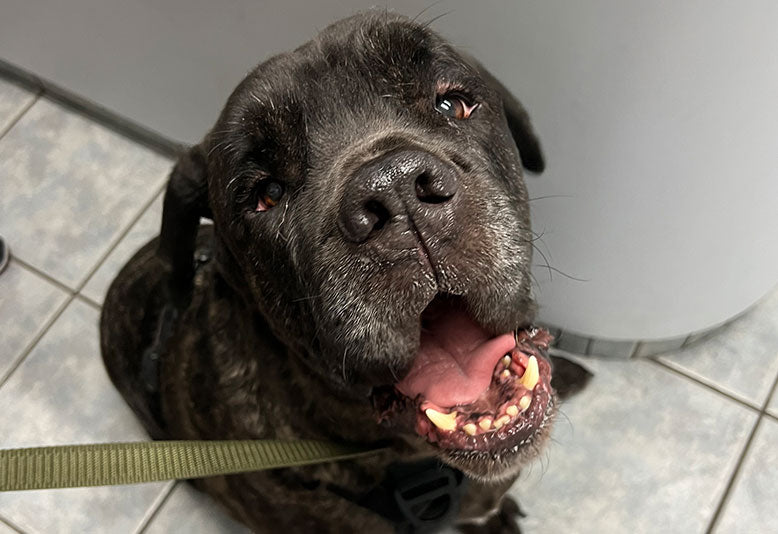
Real Results: How NeuroChew Helped Brutus Regain His Mental Clarity
Brutus was getting disoriented at night. After starting NeuroChew, he's more happy during the day and steady at night. He's back to his old self!
Tracking Progress and Knowing When to Adjust
Helping your dog get back to a healthy weight is a journey, and it’s one filled with small victories you absolutely should celebrate. Tracking their progress isn’t about obsessing over numbers; it’s about being an attentive and loving partner in their health.
A weekly weigh-in is usually the perfect rhythm. It's frequent enough to catch trends but not so often that you get stressed by normal daily fluctuations. The easiest way to do this at home is to weigh yourself, then pick up your dog and weigh both of you together. The difference is their weight—no stressful car rides to the vet needed.
Looking Beyond the Scale
While the scale gives you a number, it doesn't tell you the whole story. Honestly, some of the best signs of progress have nothing to do with pounds or ounces.
We call these the ‘small improvements that matter most,’ and they are every bit as important:
- A Brighter Attitude: Is that tail wagging a little more freely? Are they more engaged and present with the family?
- A Healthier Coat: A dull, brittle coat often gets a beautiful shine and softness back with better nutrition. This is one of the first things we notice.
- Renewed Interest in Play: Are they nudging a ball in your direction for the first time in ages? That’s a huge win.
- More Energy on Walks: Maybe they’re pulling on the leash a bit, eager to sniff that next bush instead of lagging behind.
These moments are the real indicators that you’re on the right track. It shows the changes you're making are helping them feel better from the inside out.
Setting Realistic Goals
Healthy weight gain is a marathon, not a sprint. A slow, steady pace is what you're aiming for.
A great target is a gradual increase of 1-2% of their current body weight per week. So for a 40-pound dog, that's less than a pound a week. This gentle approach helps them build lean muscle instead of just packing on fat, and it's much easier on their digestive system.
We measure success not just in numbers, but in peaceful nights and moments of joyful recognition. Small improvements truly can mean everything for your life together.
When to Check In with Your Vet
Think of your veterinarian as your co-pilot on this journey. They're your most important resource, and it's crucial to know when to lean on their expertise.
It's time to give them a call if you see any of these signs:
- No Progress: You've been diligent for a few weeks, but there’s no change in their weight or overall condition.
- Continued Weight Loss: If they are still losing weight despite your best efforts.
- Digestive Issues: Persistent problems like diarrhea, vomiting, or a complete loss of appetite.
- Lethargy: Their energy seems to be draining away rather than picking up.
Seeing these signs doesn't mean you've done something wrong. It's just your dog's way of telling you there might be an underlying issue that needs a professional look. Being observant and proactive is the best thing you can do for them.
Answering Your Top Questions About Helping Your Dog Gain Weight
When you're trying to figure out what to feed a dog to gain weight, you're bound to have questions. This isn't always a straightforward process, and it's completely normal to need a little guidance along the way. We've put together answers to some of the most common concerns we hear from dog owners just like you.
How Quickly Should My Dog Actually Gain Weight?
It's natural to want to see a change on the scale right away, but when it comes to healthy weight gain, slow and steady truly wins the race. The goal isn't just to pack on pounds; it's to build back strength and vitality.
A safe, sustainable target is for your dog to gain about 1-2% of their body weight per week. So, if you have a 50-pound dog who needs to put on some weight, you're looking at a gain of about half a pound to one pound each week. That’s it.
This gradual approach helps ensure they’re building lean muscle, not just accumulating excess fat, which is much healthier for their joints and long-term well-being. Trying to rush things can often lead to an upset stomach or other digestive issues, so patience is your best friend here.
What Can I Do If My Dog Is a Really Picky Eater?
It can be incredibly frustrating to deal with a fussy eater, especially when getting them to eat more is the entire goal. It often feels like you’re trying everything with no luck. Trust us, you're not alone in this journey.
Sometimes, all it takes is making mealtime a little more appealing. Here are a few simple tricks that work wonders:
- Warm It Up: Just a few seconds in the microwave can bring out the food's aroma, making it far more enticing.
- Add a Tasty Topper: A small spoonful of something special can make all the difference. Think low-sodium bone broth, a dollop of plain yogurt, or a little shredded, unseasoned chicken.
- Create a Quiet Zone: Some dogs get anxious around a lot of household activity. Try feeding them in a calm, quiet space where they can relax and focus on their meal.
Is It Okay to Just Give My Dog Human Food?
Sharing a bite of your own meal feels like an act of love, but it's not the best or safest way to help your dog gain weight. Many of the foods we eat are far too rich or fatty for a dog's digestive system and can lead to serious problems like pancreatitis. Some are even toxic.
Instead of sneaking them scraps from your plate, stick to adding safe, dog-friendly whole foods. A little plain cooked sweet potato or a spoonful of pure pumpkin puree can add nutrients and calories without the risks that come with our seasoned or processed meals.
Helping your dog regain their strength is about providing balanced, appropriate nutrition. It's a quiet promise you make to them, supporting their health with every carefully chosen meal.
When Should I Think About Using Supplements?
Supplements can definitely play a supportive role, but they usually aren't the first thing you need to reach for. The foundation of any weight gain plan should be a high-quality, calorie-dense diet and a consistent feeding schedule. Get that dialed in first.
If after a few weeks your dog still isn't making progress, or if your vet has identified a specific nutrient they're missing, then it’s time to talk about supplements. Things like Omega-3 fatty acids can provide healthy fats and help reduce inflammation, while high-calorie gels can give a concentrated energy boost. Just be sure to have a chat with your vet before adding anything new to their bowl.
Navigating your dog's health can feel overwhelming, but you don't have to do it alone. Here are a few more quick answers to common questions.
| question | answer |
|---|---|
| How can I tell if my dog is underweight? | You should be able to feel their ribs easily but not see them prominently. When viewed from above, they should have a visible waistline. If their hip bones, ribs, and spine are very noticeable, they are likely too thin. |
| Will more exercise help my dog gain weight? | While exercise is crucial for building muscle, too much high-intensity activity can burn more calories than they are consuming. Focus on moderate exercise like walks and light play to build lean muscle mass without over-exerting them. |
| Should I free-feed my underweight dog? | It might seem like a good idea, but it's better to stick to scheduled meals. This allows you to monitor exactly how much they're eating and ensures the food stays fresh. It also helps prevent them from just grazing and never eating a full, nutritious meal. |
| Could there be an underlying medical reason for the weight loss? | Absolutely. Unexplained weight loss is often one of the first signs of a health issue. It's essential to visit your vet to rule out any medical problems like parasites, dental disease, or metabolic disorders before starting a weight gain plan. |
Hopefully, these answers give you a clearer path forward on this journey with your dog.
At Furever Active, we know your dog’s health means everything to you. Our mission is to provide science-backed support that honors the incredible bond you share. Explore our resources to see how we can help you enjoy more good days together.
Share This Article

Support Your Dog's Brain Health with NeuroChew™
The first dog chew that supports both brain function and healthy circulation. Perfect for dogs of all ages.
- Enhances cognitive function & mental clarity
- Reduces anxiety without sedation
- Supports healthy blood circulation
- Made in USA with natural ingredients
60-Day Money-Back Guarantee • Free Shipping



